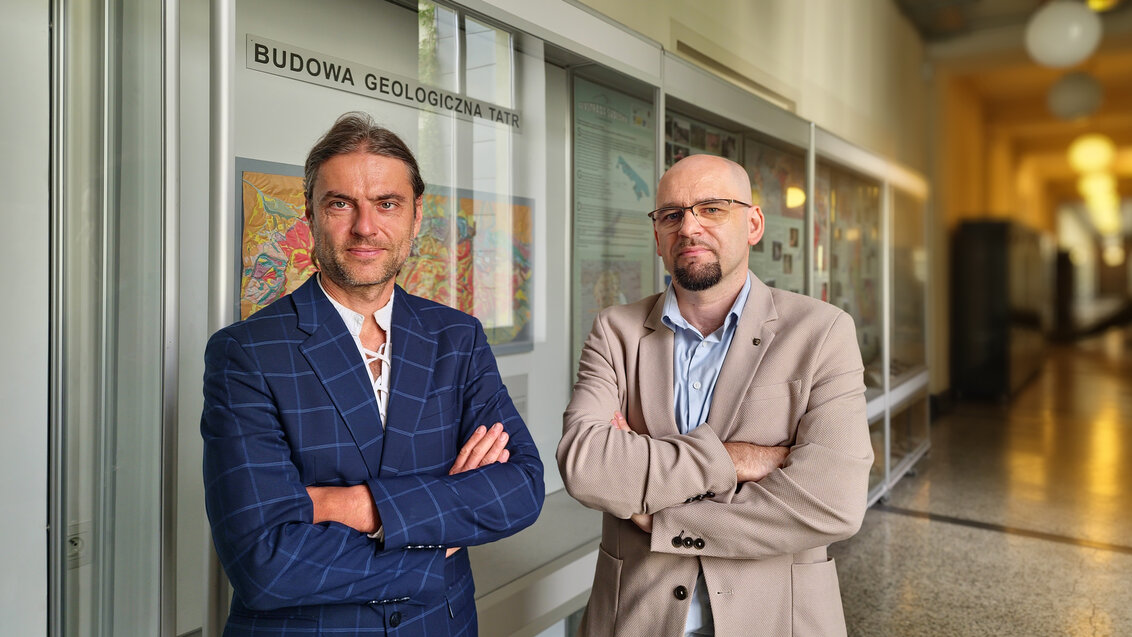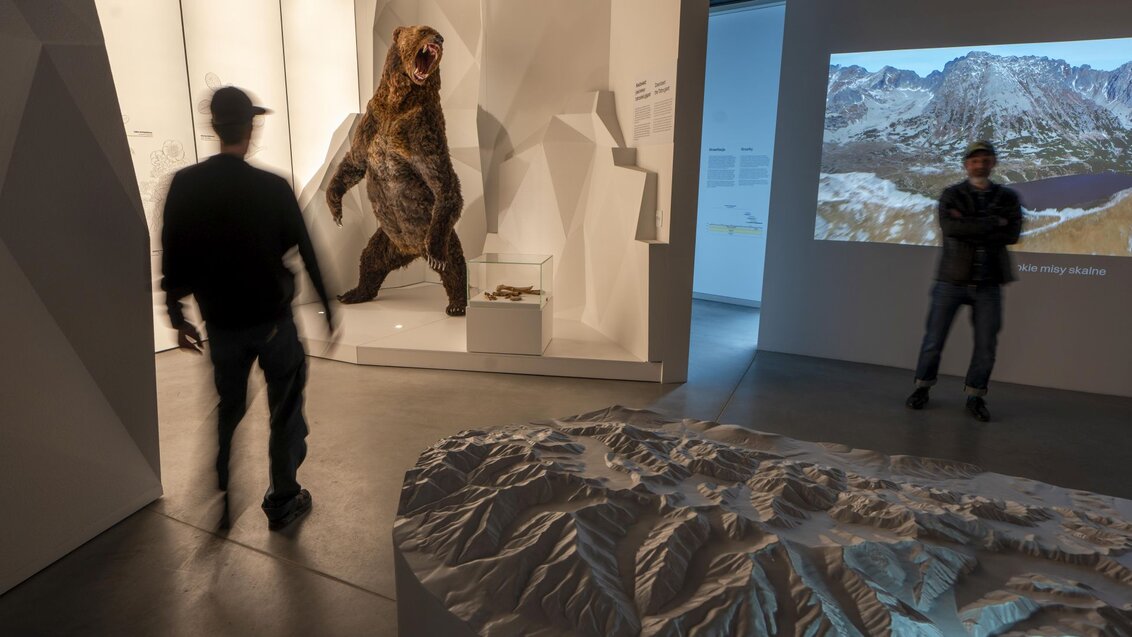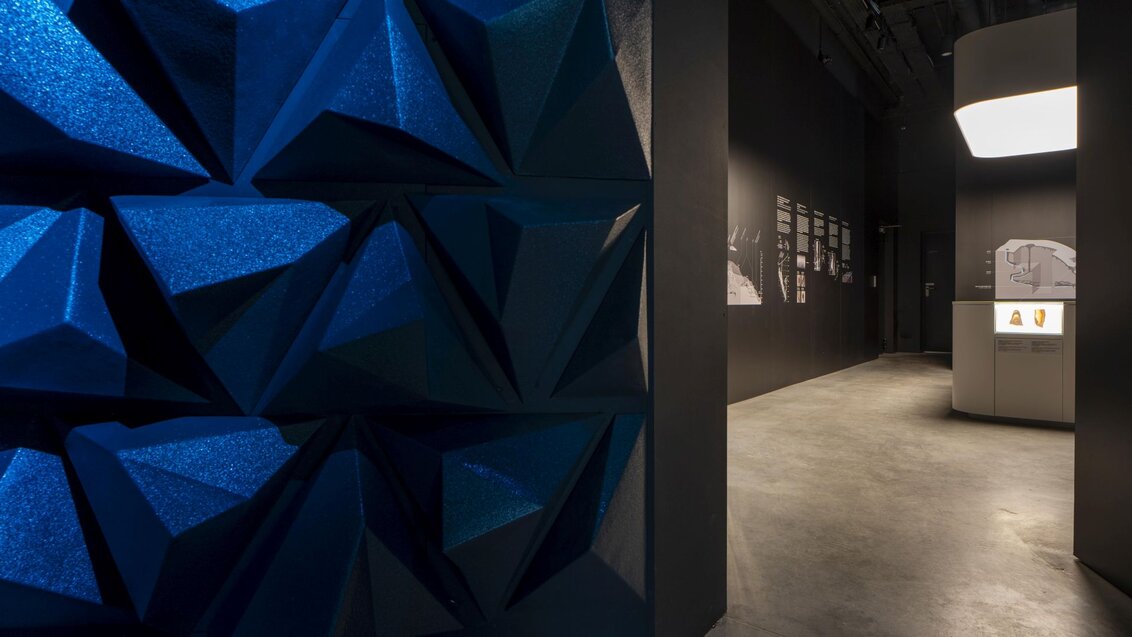
Dr Piotr Kłapyta and Dr Jerzy Zasadni. Photo by Marianna Cielecka
How to tell the hundreds of millions of years long history in an exhibition that should take up about an hour and a half? What facts should be the centre of attention? What may we resign from without any loss in the substantive value? These were some of the questions that Dr Jerzy Zasadni (AGH University Faculty of Geology, Geophysics, and Environmental Protection) and Dr Piotr Kłapyta (Jagiellonian University Faculty of Geography and Geology) had to answer, as the Tatra National Park invited them to cooperate on the development of a concept and a script for one of their latest exhibitions, i.e. Tatra Archive of Planet Earth Exhibition. The exhibition has been opened to the visitors on 18 May 2024 in Kiry, in an underground facility at the mouth of the Kościeliska, a popular Polish valley in the Western Tatras.
The aim of the exhibition is to tell the natural history of the highest Polish and Slovak mountains as well as about the very beginning of the human presence in the area. A variety of modern measures was used for this purpose, including videos, interactive exhibits, and models of life-size prehistorical animals. In cooperation with KOPTON, a company specialising in such expositions, Dr Zasadni and Dr Kłapyta tried to translate the extensive knowledge on the formation and evolution of the Tatra Mountains into an exhibition disseminating it in an approachable and engaging way.
Their idea was to use the architectural space available, divide the entire exposition into 7 topics which would tell the story of the Tatras chronologically, and present the main forces behind the shaping of the mountains. In the first three rooms, the story stars with the lengthy formation process of crystalline and sedimentary rocks which came to an end due to tectonic forces that brought the mountains to the height and shape we know today. In the next three spaces, we may learn how the mountains have been shaped by glaciers, destructive gravitational processes, and karst formations. The story concludes with the appearance of the Palaeolithic man in the Tatra Mountains and nearby.
Dr Zasadni and Dr Kłapyta co-created the substantive content presented in the first five rooms. However, there were also other scholars, both from the Jagiellonian University (JU) and the University of Silesia (USil), whose input in the content of individual issues presented at the exhibition was invaluable. They are as follows: Prof. Aleksandra Gawęda (USil), Dr Renata Jach (JU professor), Prof. Alfred Uchman (JU), Dr Jacek Szczygieł (USil professor), Prof. Paweł Valde-Nowak (JU), and Dr Magda Kowal (JU).
Tatra Archive of Planet Earth Exhibition. Photograph: Tatra National Park

Presentation of the latest state of knowledge on the Tatra Mountains
Dr Zasadni and Dr Kłapyta were exclusively responsible for the preparation of spaces devoted to glaciers and gravitational processes, which constitute their research interest. In the first one, we may see a raised-relief map of the Tatras from 20,000 years ago, mapping the location of glaciers based on another one of their maps that was deemed the best map of 2014 published in the “Journal of Maps.” The second room also does not lack in interesting items.
“We emphasise the importance of the role of rock avalanches, as the Tatras are the only place in Poland with such high-energy and spectacular mass movements. At present, they usually take the form of small rockfalls, but in the past there were some really powerful avalanches. They were even up to a few hundred metres long and moved blocks of rock as large as a detached house. At the exhibition, you will be able to watch a reconstruction of one of such avalanches which took place in Pleistocene, so ca. 2.6 million years ago,” Dr Zasadni says.
Besides the scholars, students from the Faculty of Geology, Geophysics, and Environmental Protection, specifically from the Student Research Club Azymut, were also involved in the works having prepared some elements of the exhibition. With support from Dr Piotr Strzeboński, Dr Piotr Strzelecki, and Dr Zasadni, they made analogue models of sediment movements as well as of folding and thrusting processes, then used in the videos presented in the Archive.
Dr Kłapyta stresses that the exhibition presents the current state of knowledge on the Tatra Mountains based on the latest research, some of which, like the discovery of the sub-Tatra fault’s activity, were performed only a few years ago.
“We, too, had the chance to disseminate the results of our research on various issues, like the matter of glaciers, glacial sculpting, and rock avalanches,” he mentions.
Tatra Archive of Planet Earth Exhibition. Photograph: Tatra National Park

Mountains as the planet’s history archive
The academics pay attention to the fact that the traces of the nature’s processes presented in the Archive, may be found as close as stepping over its threshold, in the Kościeliska Valley.
“Series of sedimentary rocks, faults, overlying nappes, all being the subject of the exhibition, are clearly visible in the Valley’s landscape. Whereas, when we reach the shelter in Hala Ornak or Przysłop Miętusi [a mountain pass], we shall find ourselves in a moraine zone shaped by glaciers. In turn, in Dolina Miętusia [a valley], as a matter of fact also located in close vicinity of the exhibition, there are some of the best examples of rock avalanches from the Pleistocene, namely Wantule,” the AGH University researcher indicates.
Dr Kłapyta adds that, in the valley and in its surrounding, in the massif of Czerwone Wierchy, we may also observe the best-developed caves as well as other karst forms.
The researchers encourage to take notice of the global dimension in the Tatra presentation. For the mountains witness the processes our live planet is continuously undergoing, and that was the prevailing idea behind the title “Tatra Archive of Planet Earth Exhibition.”
“During the very short life, people do not take notice of the changes the planet is going through over millions of years. That is why it is so difficult for the layman to comprehend why we compare Tatras to the Amazon rainforest or Greenland. Meanwhile, the fragment of the earth’s crust forming the Tatra Mountains has quite literally come to its present spot from the south hemisphere, passing through all climate zones on its way. The Tatra granites were being formed at the same time as the Silesian coal seams, because everything was happening in the tropical equatorial climate. Then, it was a desert area, and more recently, from a geological perspective, it was ice-capped. The Tatras have been shaped by their history, just as every nation has been shaped by its history. As geologists, we can read the story from the rocks, just like historians describing the past based on various manuscripts. So we are dealing with a planetary archive located here, in the Tatra Mountains,” Dr Zasadni claims.
“Using the example of the Tatra Mountains, we have the opportunity to learn about processes that were global in nature. This allows us to gain awareness of what a valuable asset we have at our disposal. The goal of the exhibition, besides educating, is raising awareness of the necessity to protect this heritage. We count on the tourist to gain knowledge, see for how long these rocks and the landscape have been formed and how they have evolved, and understand how vital it is to protect them,” Dr Kłapyta points out.
Tatra Archive of Planet Earth Exhibition. Photograph: Tatra National Park

Emotion-provoking message
Dr Zasadni and Dr Kłapyta are highlanders themselves, as they come from Gorce and Beskid Żywiecki. The Tatra Mountains have a special place in their hearts.
“When we used to go on hikes in our mountains, they seemed kind of ordinary. Only when we saw the Tatra Mountains from far or on TV, did we think that these had been actual mountains. When we went there back in the day, as teenagers, we could feel their immensity and the space. It really stuck in my mind,” Dr Zasadni claims.
They have met during their doctoral studies at the Jagiellonian University. Dr Zasadni carried out the research for his doctoral thesis in the Alps, whereas Dr Kłapyta in the Tatra Mountains, however, their paths have always met in the Tatra National Park. Together they participated in conferences by the Park and helped in the organisation of field trips and workshops.
“The Tatra National Park is open to research, that is why our cooperation has worked from the very beginning. Hence the invite for us to participate in the curation of the exhibition,” the JU scholar states.
A significant challenge for both researchers was to translate expert knowledge into the language of the exhibition, i.e. mainly images. This required us to sift through information and make some simplifications, a new and straining experience for experts aware of the complexity of the phenomena.
“Seeking balance between transfering knowledge and influencing emotions stood at the core of our actions. Owing to the cooperation with experts in mechanics, graphics, film, and animation, we have managed to create an exhibition not only of informative value but also visually attractive, one that engages the visitors,” Dr Zasadni indicates.
All information on visiting the Tatra Archive of Planet Earth may be found on the website of the Tatra National Park.
 AGH University Alumni Day 2024
AGH University Alumni Day 2024  20 years of AGH University-SIT partnership and inauguration of Alumni Association in Tokio
20 years of AGH University-SIT partnership and inauguration of Alumni Association in Tokio  Projects by AGH University Main Library with funding from Scientific Social Responsibility programme
Projects by AGH University Main Library with funding from Scientific Social Responsibility programme  Honouring those we lost this year
Honouring those we lost this year  On energy transformation and more. Distributed Energy Congress
On energy transformation and more. Distributed Energy Congress  AGH University to establish AI Factory
AGH University to establish AI Factory 

